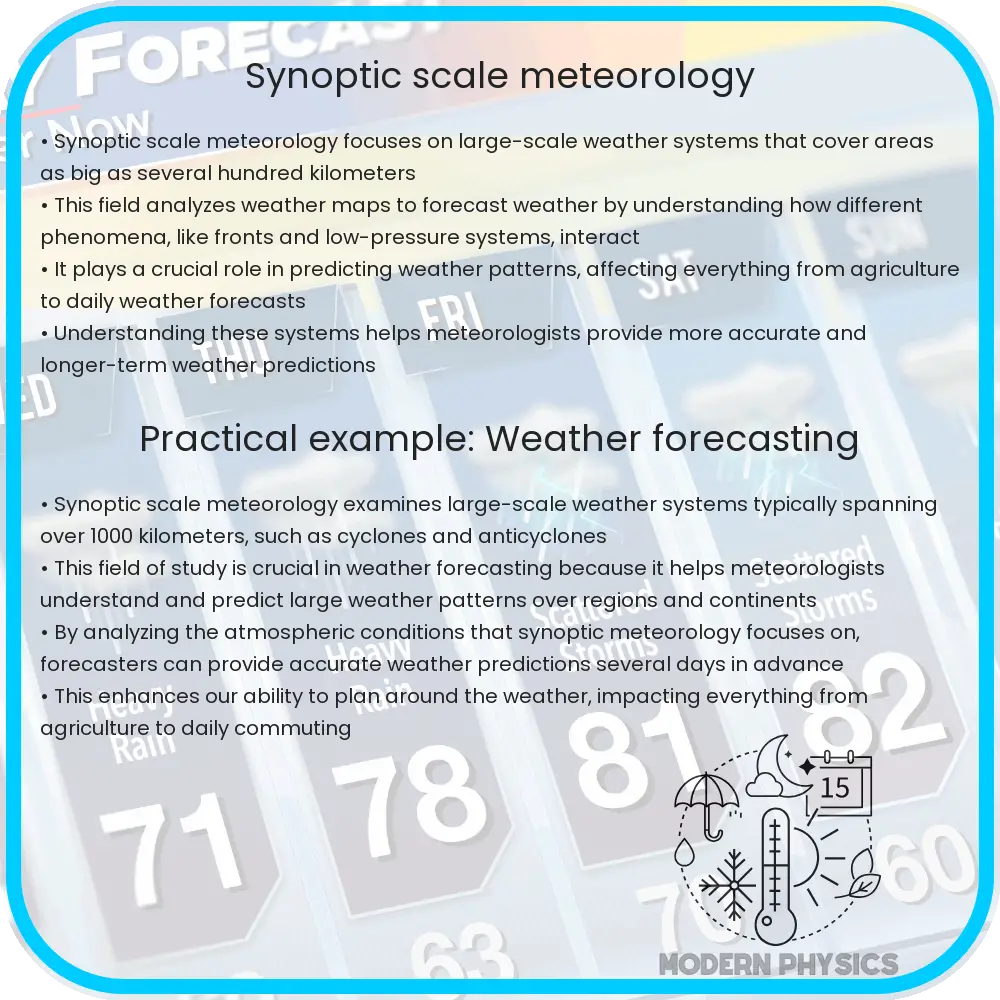Learn about synoptic scale meteorology, which analyzes large-scale weather patterns across regions up to 5000 kilometers, using advanced tools for accurate forecasting.

Understanding Synoptic Scale Meteorology
Synoptic scale meteorology focuses on understanding weather conditions and forecast patterns that cover large areas, typically ranging from 1000 to 5000 kilometers across. This field is essential for predicting weather over regions as large as continents or entire oceans. In this article, we will explore the fundamental concepts of synoptic scale meteorology, including common weather patterns, tools used for analysis, and methods for forecasting.
Key Patterns in Synoptic Scale Meteorology
The synoptic scale encompasses large-scale atmospheric motion primarily influenced by the Earth’s rotation and energy from the sun. Some of the predominant patterns observed include:
- High and Low Pressure Systems: Areas of high (anticyclones) and low (cyclones) atmospheric pressure that govern much of the weather changes, including winds and precipitation.
- Fronts: Boundaries between two different air masses. Fronts can be cold, warm, occluded, and stationary, each affecting the weather differently.
- Jet Streams: Fast flowing, narrow air currents found in the atmosphere around 10 kilometers above the Earth’s surface. They play a major role in determining the path of weather systems.
Tools for Synoptic Analysis
Meteorologists use a variety of tools to analyze and predict synoptic scale weather patterns:
- Weather Maps: Provide a graphical representation of atmospheric conditions over a large area at a given time, using symbols to denote different weather systems like pressure areas and fronts.
- Satellite Imagery: Offers real-time data on cloud patterns, wind movement, and weather systems over extensive areas.
- Radiosondes: Instruments carried by weather balloons that collect data on temperature, humidity, and atmospheric pressure as they rise through the atmosphere.
These tools help meteorologists visualize the synoptic scale dynamics and assist in the accurate forecasting of weather patterns.
Forecasting Techniques in Synoptic Meteorology
The forecasting of weather based on synoptic scale analysis involves interpreting data from various observational tools and applying scientific principles. Forecasters use different computational models that simulate the atmosphere’s behavior based on physical laws. Two main approaches in forecasting include:
- Numerical Weather Prediction (NWP): Uses mathematical models of the atmosphere and oceans to predict weather based on current weather conditions. The equations used in NWPs account for various physical processes such as thermal dynamics, fluid dynamics, and the interaction between the Earth’s surface and the atmosphere.
- Statistical Methods: These rely on historical data and statistical techniques to forecast future weather conditions. These methods are particularly useful in areas where long-term weather data patterns have been established.
Advancements in computing power and the use of satellites have greatly enhanced the accuracy of synoptic scale forecasts, making it possible to predict weather patterns days in advance with significant precision.
The Impact of Climate Change on Synoptic Scale Meteorology
Climate change is increasingly influencing synoptic scale meteorological patterns, altering traditional weather systems and their predictability. The shifts include:
- Intensity of Weather Events: Increased sea surface temperatures can enhance the energy available for storm systems, leading to more intense hurricanes and tropical cyclones.
- Altering Jet Streams: Warming temperatures at the poles can weaken the temperature gradient that drives the jet streams, potentially leading to slower, more meandering jet streams which can cause prolonged weather conditions.
- Changing Precipitation Patterns: Shifts in climatic zones may change where and how much precipitation falls, impacting agricultural practices and water resources management.
Understanding these changes is crucial for improving the accuracy of long-term forecasts and preparing for more extreme weather phenomena that may arise as the climate continues to change.
Challenges and Future of Synoptic Scale Meteorology
Despite technological advancements, there remain significant challenges in synoptic scale meteorology:
- Complexity of System Interactions: The atmosphere is a chaotic system with many interacting components, making precise long-term forecasts inherently difficult.
- Data Limitations: While satellite and radar improve coverage, certain regions of the planet, like remote oceans and the upper atmosphere, remain under-monitored.
- Evolving Climate Conditions: As our climate changes, historical data becomes less predictive, requiring constant updates to models and methodologies.
The future of synoptic scale meteorology lies in enhancing computational models, improving global cooperation for data sharing, and integrating AI technologies to better predict complex weather systems. Continuous research and investment are essential to understand and adapt to the evolving dynamics of Earth’s atmosphere.
Conclusion
Synoptic scale meteorology plays a vital role in our understanding of weather patterns over large geographical areas. From predicting seasonal weather patterns to preparing for extreme weather events, this field provides key insights that affect various aspects of disaster management, agriculture, and daily life. The integration of advanced tools, such as numerical weather prediction and statistical methods, along with a deeper understanding of climate change impacts, allows meteorologists to offer more accurate forecasts. Continuous exploration and adaptation in response to atmospheric changes are crucial in furthering the precision and reliability of weather forecasts and in effectively managing the challenges posed by an ever-changing climate.
